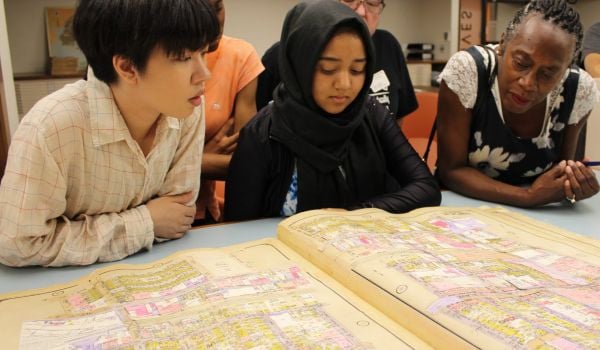Concerned with the rapid gentrification of many of their neighborhoods, and the potential displacement of low-income residents that may accompany it, cities across the United States have been looking at ways to help long-term residents remain in place while housing markets change around them. “Development without displacement” has become a rallying cry for advocates from Philadelphia to San Francisco. Cities like Austin and San Antonio have begun to create their own anti-displacement strategies, while the Association for Neighbhorhood & Housing Development has published a policy toolkit to help cities protect residents from being pushed out.
But at what point does an effort to keep existing residents in their neighborhoods look too much like an attempt to keep outsiders out?
This summer, after Seattle Mayor Jenny Durkan signed an executive order directing city departments to find ways to increase housing affordability and prevent displacement, the Seattle City Council approved a new set of housing funding policies. Among them is a practice called Community Preference, which, in Seattle’s case, will give affordable-housing developers the option to set aside a portion of units in new buildings for people who are already living in the surrounding neighborhood.
“We know that there have been people who have been residents of Seattle for a long time, and as the city has grown and as there is increasing prosperity, there is also an interest in allowing people who were a part of the fabric of communities to be able to stay in those communities,” says Emily Alvarado, acting director for Seattle’s Office of Housing. “Displacement is happening, and it is harmful to people when they are unable to stay in their communities.”
The policy in Seattle will be implemented on a case-by-case basis. Any time a developer is using city subsidy to build affordable housing in a neighborhood that has been identified as a high risk for displacement, the developer is required to “affirmatively market” the units to people who are already living in the neighborhood, and has an option to hold some of the units aside for a lottery open to applicants from the surrounding area. For each project, the developer may submit a plan for a local-preference lottery to the Office of Housing for approval. Alvarado says the Office is also expecting to issue community preference guidelines later this year.
The city has tried to learn from similar policies in New York, San Francisco, and Portland, Alvarado says, because in some cases, “community preference” policies can run afoul of fair-housing laws. San Francisco, for example, became involved in a dispute with the federal Department of Housing and Urban Development over a policy giving neighborhood residents a first shot at some new affordable housing, because HUD said it could entrench racial segregation patterns in the city. And New York City is currently involved in a lawsuit related to its own community preference policy, which has been in place for decades and which sets aside half the units in affordable housing lotteries for neighborhood applicants. In July, the city was forced to release a study that suggested its policy locks segregation in place.
For Craig Gurian, the executive director of the Anti-Discrimination Center and lawyer representing three women who are suing New York over the affordable housing lotteries, community preference policies are so clearly segregationist that even the name is deceitful. The Trump administration could label its immigration policies as “community preference,” Gurian says, but the effect — keeping immigrants out of the country — would still be the same.
“These policies are outsider-restriction policies,” Gurian says.
Gurian cited statistics suggesting that some 85 percent of applicants for New York City’s affordable-housing lotteries applied for housing multiple times, and most frequently outside of their own neighborhoods. It’s offensive, he says, for the city to suggest that what low-income residents want more than a range of housing opportunities is to stay in the racially segregated neighborhoods where they live.
“It is absolutely a worthwhile goal to make sure that everybody has a genuine chance to exercise the choice to stay in the apartment or house they are currently living in or to move,” Gurian says. “The way you do that is you have actual, concrete, vigorous, aggressive anti-displacement and anti-harassment policies and pro-tenants and pro-rent-regulation policies. You do not do that by locking in segregated housing patterns.”
In 2015, Robert Schwemm, a professor at the University of Kentucky College of Law, wrote an essay for The NYU Furman Center suggesting that community preference policies were often an “unnecessary barrier to minorities’ housing rights.” Even when local-preference rules weren’t explicitly being used to keep people of color out of white neighborhoods, they could be subject to challenge under the “disparate impact” doctrine of federal fair housing law, Schwemm wrote.
New York’s policy is still problematic, Schwemm tells Next City. But providing opportunities for people to remain in gentrifying neighborhoods is a good goal, he says, and there may be ways to create community preference policies that don’t reinforce racial segregation.
“Cities that I tend to think of as progressive cities are trying alternatives,” Schwemm says. “And I think that should be encouraged.”
Seattle is trying to overcome its history of racial segregation in housing, Alvarado says. And one of the ways it’s hoping to avoid the potential pitfalls of community preference policies is to only allow it to be implemented in neighborhoods that are already racially diverse. She says that the city learned from San Francisco’s dispute with HUD that it would need to draw the boundaries for local preference in such a way that it would avoid entrenching segregation. The Office of Housing will be able to help shape every use of the community preference policy, she says, and it plans to monitor its use over time to make sure it isn’t making segregation worse.
“I think that policies can be designed in ways that they have unintended consequences,” Alvarado says. “Our goal is to make sure that a portion of rental units in affordable-housing developments are set aside with a preference for applicants who have local ties. It is not intended to undermine our prevailing priority for affordable housing, which is to provide housing choices in as many neighborhoods as possible.”
EDITOR’S NOTE: We’ve corrected an error that misattributed the anti-displacement toolkit to All-In Cities Anti-Displacement Policy Network instead of Association for Neighbhorhood & Housing Development.
This article is part of Backyard, a newsletter exploring scalable solutions to make housing fairer, more affordable and more environmentally sustainable. Subscribe to our weekly Backyard newsletter.

Jared Brey is Next City's housing correspondent, based in Philadelphia. He is a former staff writer at Philadelphia magazine and PlanPhilly, and his work has appeared in Columbia Journalism Review, Landscape Architecture Magazine, U.S. News & World Report, Philadelphia Weekly, and other publications.
Follow Jared .(JavaScript must be enabled to view this email address)


















